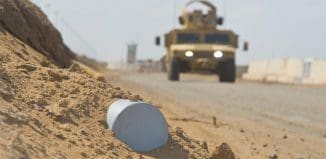Improvised explosive devices are still a threat
This post is also available in:  עברית (Hebrew)
עברית (Hebrew)

U.S. troops in Afghanistan are months away from the 2014 drawdown, but this latest statistic could lift some weight off their shoulders.
According to Military Times, attacks from improvised explosive devices dropped 19 percent for the three-month period that ended July 31, compared with the same time period in 2012.
Nevertheless, explosive ordnance disposal technicians train year-round to ensure the safety of deployed service members.
While IED attacks may be down, roadside bombs remain the top threat to U.S. troops, causing 61 percent of all casualties, according to the Joint IED Defeat Organization.
It’s worse for Afghan security forces, which have seen attacks increase 74 percent in the same three-month period this year.
July 2012 was the worst month for IED attacks on U.S. troops. Insurgents planted more than 2,000 bombs that month.
But there are also fewer U.S. forces in Afghanistan this year, about 60,000, and they’ve taken on more of an advisory role. That accounts in part for the increase in attacks on Afghan soldiers and cops who now lead most operations against insurgents.
Homemade explosives account for nearly three-quarters of IEDs. For years, the main ingredient in those explosives was ammonium nitrate fertilizer. In the last few years, U.S. officials have pressed Pakistan hard to limit the flow fertilizer into Afghanistan.
Unfortunately, insurgents have switched to a different source, potassium chlorate, the key ingredient in matches. Now more than half of all IEDs in Afghanistan are powered by potassium chlorate, compared with 25 percent last year.
U.S. troops find and defuse bombs better than ever. Soldiers and Marines on foot patrol now find 85 percent of makeshift bombs compared with 80 percent last year.































